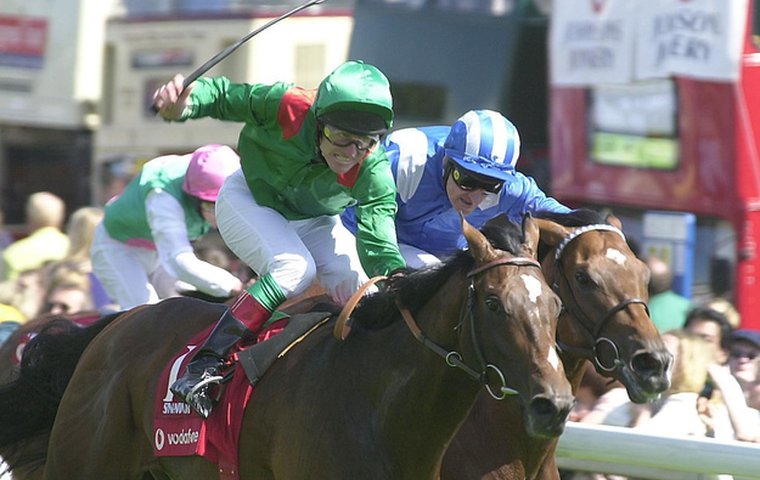
Continuing TRC’s ‘My Favorite Racehorse’ series, author and broadcaster Donn McClean, chief racing writer with The Sunday Times in Ireland, explains his special affection for the 2000 Arc and dual Derby winner Sinndar.
So it’s My favourite racehorse, it’s a personal thing. Resonance all over the place. Like, where were you when Sinndar won the Epsom Derby? At the top of the stands, willing him home with every sinew of my body, that’s where.
You think that you can’t influence a horse in a finish when you are not on his back, but you can. If you lean far enough and hard enough to your right and hold your breath for long enough, you can will a horse home in the Epsom Derby.
They went fast in the 2000 Derby. Kingsclere seemed to think that the winning post was at the top of the hill, before you sweep down around Tattenham Corner, not at the bottom after you have negotiated the hills and the cambers, and he went like a sprinter through the first three furlongs. That set the tempo for the race, and that suited the stamina-laden Sinndar down to the ground.
Johnny Murtagh always had the Aga Khan’s horse in the perfect position: wide and prominent around the first right-handed kink, three off the rail and just behind the leaders as they started to wheel left-handed.
They quickened at the three-furlong pole, and Sinndar was caught flat-footed. Johnny actually pulled his stick out, and there was that horrible nano-second during which you thought that the John Oxx-trained colt was going to be swallowed up by the unforgiving pack and finish seventh. But it only lasted for a nano-second. Just an instant of doubt.
Then he picked up. Sakhee was travelling better, Richard Hills was just nudging along whereas Johnny was driving, but you knew all about Sinndar’s will to win. His trainer had told us about it, and we had seen it on his last run as a juvenile in the G1 National Stakes at The Curragh. He looked destined for fourth place entering the final furlong that day, but got up to win by a head.
Start of a change of fortune for the Irish
Add that will to win to his pace and his class and his stamina, and you have a potent force that is almost impossible to repel. And his stamina kicked in. Sakhee went for home from outside the two-furlong pole, and went fully two and a half lengths clear, but that was as far as he ever got. Sinndar arrested the deficit, and set about clawing it back.
The press stand at Epsom was so high in the stands in those days that you could have been in the Goodyear blimp. The aerial view gave you an unusual perspective. You had to look alternately between the horses and the winning post to see how much time the Irish horse had left. Like a golfer, watching his ball in the air after it has left the blade of his nine-iron, alternating his gaze between the in-flight Top Flight and the flag in the middle of the green, and knowing that it is good.
This was good. The deficit was a length when they passed the furlong pole, a half-length when they passed the green double-decker bus in the infield, a neck when they passed the red one. By the time they got to the start of the Vodafone signage, however, Sinndar was in front, and the somersaults in your head had begun.
Ireland simply didn’t win the Derby in those days. There were 15 Epsom Derbys run between Secreto (1984) and Sinndar, and there was no Irish-trained winner. There have been 14 Derbies run since Sinndar, and Irish horses have won seven of them. Different era.
John Oxx has been rightly lauded for his management of Sea The Stars’ racing career, through the horse’s six G1 wins as a 3-year-old, one every month, rat-tat-tat-tat-tat-tat. But we knew before Sea The Stars that the affable and talented trainer could plot the route for a top class 3-year-old colt through his classic season, because he did it with Sinndar.
After the Epsom Derby came the Irish Derby. It’s the natural progression. The record book says that Sinndar won the Curragh classic by nine lengths, but it was not as straightforward as that sounds. The ground was softer than Sinndar liked and he came under pressure at the top of the home straight. In the end, however, his class saw him through.
In truth, Sinndar’s career was all about class. Afforded a short break after the Irish Derby, he eased home in the Prix Niel in September, and that set him up for the Arc. Okay, so Montjeu probably didn’t run his race at Longchamp that day, but it is difficult to think that even a peak-form Montjeu would have been able to concede the 8lb weight-for-age allowance to Sinndar, such was the form in which John Oxx had produced him on the day. Again, as in the Derby, the Grand Lodge colt bridged a long gap back to the previous Irish winner. It had been 22 years since Alleged had won the second of his brace.
It is regrettable that we did not see Sinndar race again after that, but that’s the thing with your favourite racehorses: they always leave you wanting more.
Sinndar will relocate from the Aga Khan’s Haras de Bonneval in France to Haras du Lion in the west of France for the 2016 breeding season. The 18-year-old son of Grand Lodge will stand at a fee of €3,500. He has also stood at the Aga Khan’s Gilltown Stud in Ireland. He is the sire of more than 200 winners, including European G1 winners Shareta, Shawanda, Rosanara and three-time Arc runner-up Youmzain.

